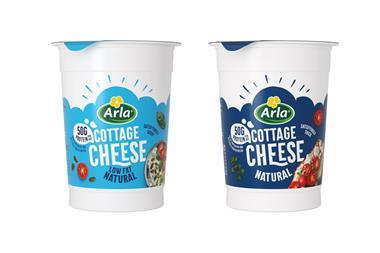Packing it in at home and abroad
The creation of Arla Foods gave Denmark new clout on world markets and in meeting the demands of global multiples. But their is no complacency at the giant as new product development testifies, says Ed Bedington
Consolidation is the name of the game in the Danish dairy industry especially following the creation of Arla Foods.
Denmark's biggest dairy company MD Foods took the initiative to expand outside its own boundaries when it joined forces with one of Sweden's largest dairy outfits Arla in a cross boundary alliance that created the giant new company.
Consolidation has been a key factor of the Danish dairy industry for some time.
Since 1965, the number of herds in Denmark has fallen dramatically from more than 135,000 to a projected 6,000 in 2005. The number of cows has fallen from 1,349,200 to a projected 620,000.
So, of course, the number of cows per herd has increased significantly, going from 10 per herd in 1965 to a predicted 103 in 2005.
Hand in hand with that is a dramatic increase in yield per cow. So although the numbers have shrunk, efficiency has increased more than tenfold.
There are around 8,500 dairy farmers in Denmark, producing 4.5 billion kilograms of raw milk. Only a third is consumed by the Danes themselves.
With two thirds of the country's dairy production going abroad, exports are not just crucial to the dairy industry, but also an important part of the country's economy.
Arla Foods has about 90% of the Danish dairy market. MD Foods had previously merged with Klover Maelk in 1999 to form Denmark's biggest dairy company.
Arla's product business unit controller Henrik Nygaard says the fact Arla dominates the Danish market is not considered a problem.
Says Nygaard: "We don't consider Denmark a single market as such, but rather part of a bigger European market."
The company is still grappling with the logistics of the merger, and despite similarities between Sweden and Denmark, the combination of cultures has thrown up some difficulties.
Nygaard says: "The Danish and Swedish mentalities are very different. At the first couple of meetings, language was a problem. To us Danes, yes' means yes, go for it - let's do it. To the Swedes, however, it means, yes, let's think some more about it!
"But as we go along we're getting better. It's improving all the time, but it's like any merger. You'll always have initial frictions."
According to Nygaard the recent consolidation in the dairy industry has been vital for survival.
"The world of dairy has traditionally always been fragmented, but it now needs to consolidate to keep up with retailer consolidation.
"Retailers are looking to cut out costs and it's the smaller businesses that will suffer."
Henning Mortensen, a spokesman for the Danish Dairy Board, the central trade organisation of the Danish dairy industry, agrees that consolidation has been important: "Because the supermarket chains are in such strong positions, it's a big challenge for dairy producers not to be overrun and have their prices pushed down to the point where they become unviable."
However Mortensen suggests there will be limits to the amount of consolidation given the go ahead in the future.
"I don't know how much the competition authorities will allow before they say no. I'm not sure we'll see very many big mergers. But we may well see a lot of strategic alliances between companies."
So all this consolidation has meant smaller dairy producers finding themselves being squeezed out of the market.
According to Mortensen there is still room for smaller firms. But they have to find a niche or speciality product if they have any realistic hope of surviving.
At the moment the export market is looking healthy. Mortensen says prices are good and are holding steady.
"The situation is better than it was a year or two ago, and we have had a relatively steady market for quite some time, although it's difficult to say for how long, of course.
"The price Arla Foods pays to farmers for milk is set to go up 3%-4% because exports have been good.
"We definitely do not need any more BSE or foot and mouth crises as any more will really hurt the market." Fortunately, Denmark has managed to remain FMD free during the recent outbreak and the dairy industry escaped relatively unscathed.
However Nygaard says the costs of cleaning products rose with the increase in use of disinfectants.
European bureaucracy is another big issue facing the Danish dairy industry.
The European Union quota system for milk, which has been in operation since 1984, gives each individual farmer a limit on the amount of milk he is allowed to deliver to the dairy.
Mortensen says the system means farmers are prevented from individual development and ensures the structure of the industry is locked.
"Especially now, when we are moving towards more free trade, it is obvious that the quota system is more of benefit to our competitors on the world market, because they are able to produce what they want without restrictions.
"This means we in the EU are less competitive on the world market. The EU has lost a lot of market share since the introduction of the quota system."
He adds that new members to the EU in Eastern Europe are unlikely to find themselves restricted by quotas and that should be the case for all EU members.
Politics aside, research and development is playing a bigger part in the Danish dairy world and Mortensen says greater investment is being made all the time.
"We're going to see a lot of new products coming on to the market. There are some exciting developments."
One such innovation has been Arla's launch of Cravendale Purfiltre milk, specially filtered for spoilage bacteria before being pasteurised.
The product, which is attaching a brand name in a traditionally unbranded area, has proved a big success in the UK. The company is now planning to expand the product's production in a multi-million pound development.
UK chief executive David Salkeld said: "Traditionally, consumers have had a David Coulthard approach to buying milk, flying up to the milk chiller and, without stopping, grabbing their preferred fat type before accelerating away."
Arla claims Cravendale promotions, TV advertising, point of sale material and door drop coupons have encouraged shoppers to linger for a second or two when choosing milk.
Arla estimates that next year Cravendale will have a brand value of approximately £35m.
As well as developing entirely new products, the company is also using the weight of established brands to give an extra boost to new concepts, particularly in the case of Lurpak Spreadable which has been extremely successful, doubling the value of Lurpak since its launch in 1997, says Nygaard.
But spreadables were not always a success, he adds: "We tried launching them a number of times as own label products and each time they failed.
"But then we put the Lurpak name to it and it took off."
Lurpak is increasing in value, despite being in a declining sector. In order to maintain the brand success, Arla is supporting Lurpak with a £9m ad campaign this year.
This will include TV commercials featuring that regular and much loved character Douglas the butterman, who has been starring in Lurpak commercials for over 15 years.
Arla is also hard at work overhauling the speciality cheese market.
The Discover range of cheeses was launched following research which showed consumers find the speciality cheese section so confusing that more than 40% never buy any.
Discover was launched with the intention of making speciality cheese more accessible.
Product manager for cheese Mikael Horsboll says: "Until now the vast array of shapes, sizes, names and types of speciality cheese has meant many customers are bewildered.
"By introducing Discover we are creating a brand that makes choosing speciality cheeses more straightforward, thus bringing new consumers into the category."
The range features 14 cheeses including Mozzarella, Feta with Olives, and Emmental.
The packs all explain the cheeses' flavour characteristics, texture and origin, along with a quick and easy recipe and strength indicator.
Arla meanwhile is looking to build on its success in the UK.
Nygaard says: "Northern Europe is our traditional home market, but we would like to see both Germany and the UK built into that, so they become home markets as well."
But Nygaard acknowledges there are significant differences between the various European markets: "In cream, for instance, the UK consumes around 1kg per head, whereas in Sweden that amount is around 10kg per head.
"You can't just take the Swedish range and launch it in the UK, it would not work."
But he adds the differences could well prove to be useful in development terms.
"We are finding out what different markets are doing differently and why. There are plenty of learnings we can take from Europe for the UK market. We're just not sure what they are yet, though!"
{{Z SUPPLEMENTS }}
Close menu
- Home
- Retail & Wholesale
-
Products & Suppliers
- Back to parent navigation item
- Products & Suppliers
-
Product Categories:
- Back to parent navigation item
- Product Categories:
- Alcoholic drinks
- Bakery
- Cereals & breakfast
- Cheese
- Chicken & poultry
- Chocolate
- Confectionery
- Crisps, nuts & snacks
- Dairy
- Fish
- Fresh produce
- Frozen
- Household
- Meat
- Own Label
- Sauces & condiments
- Seasonal
- Soft drinks
- Vaping
- Vegan & plant-based
- World foods
- Suppliers
- People
- Reports & Data
-
Topics A-Z
- Back to parent navigation item
- Topics A-Z
-
Popular topics:
- Back to parent navigation item
- Popular topics:
- Cost of living crisis
- Crime
- Deposit Return Schemes
- Finance
- Government & Regulation
- Health
- Inflation
- Loyalty
- Marketing
- Mergers & Acquisitions
- New Product Development
- Sourcing
- Supply chain
- Sustainability & environment
- Technology
- Ultra Processed Foods
- Vaping
- A-Z all topics
- Content by type:
- Events
- Ask iA (beta)
- Subscribe now
Sign in to comment on this article
Not logged in before? Register for FREE guest access today.
You will be able to:
- Read more stories
- Receive daily newsletters
- Comment on stories
Advert
















No comments yet